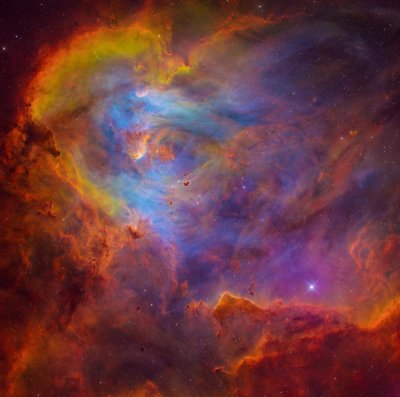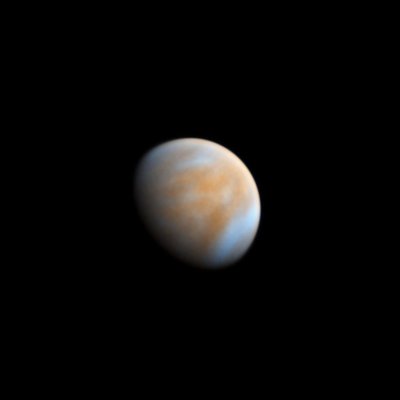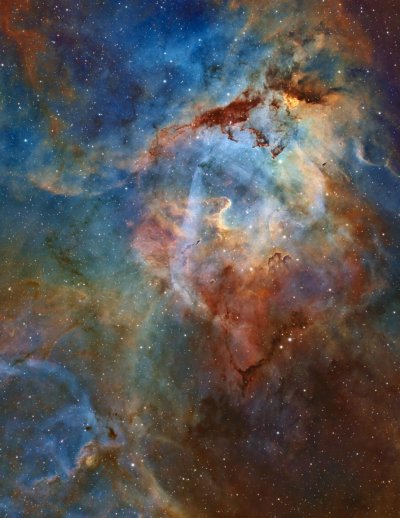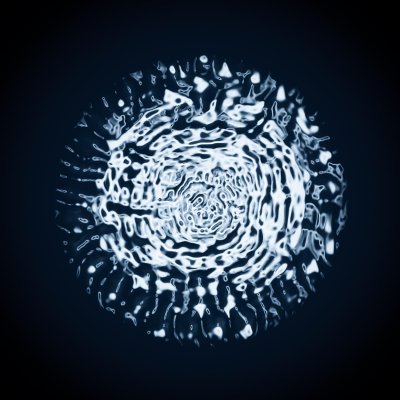The universe is filled to the brim with weird and wonderful sights, which we are often lucky enough to see thanks to the skills of astrophotographers.
This year's Astronomy Photographer of the Year competition, run by the Royal Observatory Greenwich in the U.K., showcases some of these unique spectacles, ranging from the roaring surface of our sun to our galactic neighbor Andromeda.
Giant Plasma Arc
The overall winning entry of the Astronomy Photographer of the Year 2023, taken by Marcel Drechsler, Xavier Strottner and Yann Sainty, shows the Andromeda galaxy next to an unexpected hazy blue cloud.

This cloud, never before seen, is thought to be an enormous arc of plasma stretching across the space between the Milky Way and our neighboring galaxy, situated 2.5 million light years away.
"What you see is [a] gigantic blue arc of ionised oxygen gas that has never been seen before," amateur astronomer and astrophotographer Drechsler explained in a statement.
This picture reveals how new findings are always being uncovered just under our noses, as we have been observing Andromeda for over 100 years. The reason that the arc—christened the Strottner-Drechsler-Sainty Object 1 (SDSO-1)—had not been spotted before is that it only emitted light in the Oxygen 3 (OIII) wavelength, and was very faint. OIII is a wavelength of light emitted by clouds of oxygen, which only comprise around 1 percent of gas in the universe: hydrogen, by contrast, makes up over 75 percent.
"It was an absolute accident," Drechsler said. "No one expected to see it and that's why it's called Andromeda, Unexpected, because we wanted to take a beautiful image of the Andromeda Galaxy. And we looked at the first data and we spotted this hazy smudge on the edge of the image."
Red Sprite Lightning
The winner of the competition's "Skyscapes" category is a spectacular red sprite lightning display, photographed by Angel An.
"Sprites are large-scale, lightning-like discharges that happen above thunderstorms," Caitano L. da Silva, a physics professor at New Mexico Tech, previously told Newsweek.
"They happen in response to powerful cloud-to-ground (CG) flashes in the underlying thunderstorms. These CG flashes radiate a strong electric field that creates sprites at the edge of the lower ionosphere, aka the edge of space," da Silva said. "Sprites are brief, but are huge, 50 km [30 miles] tall by 50 km [30 miles] across, about the size of a small town."
This image was taken at Lake Puma Yumco, in Tibet, China.
"I was standing on the highest ridge of the Himalaya mountains, enjoying the dancing lightning sprites like gorgeous fireworks in the night sky," Angel said. They acted as fairy-like creatures, giving a transient firework show for the audience on Earth. Seeing this extremely rare phenomenon of atmospheric luminescence with such high intensity was something that I have never witnessed before."
Solar Tendrils
The winner of the "Our Sun" category is a close-up of the sun's surface taken by Eduardo Schaberger Poupeau, showing a long tendril of solar plasma.

"This is such a clever image as while we have seen the granulation and surface of the Sun before, I've never seen a filament shaped like a question mark before," Sheila Kanani, competition judge, said in a statement. "If you zoom into the surface of the Sun, the image has a paint-like quality—I feel like I can see the brush strokes. There's a sense of movement and you can almost see the question mark filament moving if you stare long enough."
Mars and the Moon
The "Our Moon" category was won by an image of the occultation of Mars by the moon, which is when Mars passes behind the moon in our skies. This image shows Mars as it peeked out from behind our satellite on December 8, 2022, as taken by Ethan Chappel from Texas.

"To capture the level of detail on Mars that you see here takes a huge amount of skill and practice," Steve Marsh, a competition judge, said in the statement. "Combined with a crisp, clear, perfectly processed lunar limb, the result is like taking a gigantic telephoto lens into lunar orbit itself! This image is a technical marvel and a real treat to look at. Two factors which make it a worthy winner in this category."
Northern Lights
The winner of the "Aurorae" category was of a long flame-like wisp of aurora, taken by Monika Deviat in Finland. Auroras are caused by solar wind slamming into the Earth's atmosphere and magnetic field, causing gases to emit light in the form of the northern and southern lights.

"This photograph is an aurora abstract. I focused on this structure as it looked like a painter's brushstroke across a canvas. It's not the usual corona or big nightscape scene, but I thought it was a unique and beautiful shape with the feathered ends. I pointed the camera almost straight up to capture this formation," Deviat said in a statement.
New Nebula
The winner of the "Stars and Nebulae" category was an image of a galactic nebula around the YY Hya star, taken by Marcel Drechsler from Germany and Xavier Strottner from France over 360 hours of exposure across 100 nights.
This nebula was previously unknown to science.

"In its centre, a pair of stars surrounded by a common envelope was found. For the first time, amateurs and scientists have succeeded in providing evidence for a fully developed shell of a so-called 'common envelope system'," the photographers explain in a statement.
Several other images won their categories, while tens of others filled the longlist and shortlists, all revealing the beauty and mystery of the universe.






"Once again, entrants to the Astronomy Photographer of the Year competition have conspired to make things difficult for the judges, with a flood of high-quality images covering an amazing range of targets. The highlight of this year is perhaps a number of genuine discoveries being imaged, but we've had wonderful efforts in every category," Ed Bloomer, an astronomer at Royal Observatory Greenwich, said in a statement.
Do you have a science story to share with Newsweek? Do you have a question about astrophotography? Let us know via science@newsweek.com
Uncommon Knowledge
Newsweek is committed to challenging conventional wisdom and finding connections in the search for common ground.
Newsweek is committed to challenging conventional wisdom and finding connections in the search for common ground.
About the writer
Jess Thomson is a Newsweek Science Reporter based in London UK. Her focus is reporting on science, technology and healthcare. ... Read more
To read how Newsweek uses AI as a newsroom tool, Click here.





